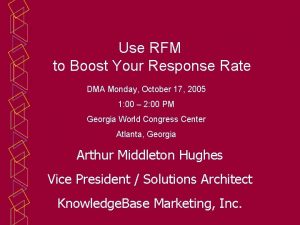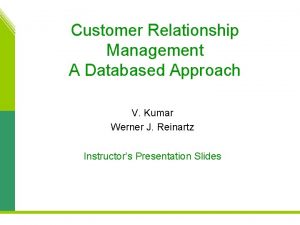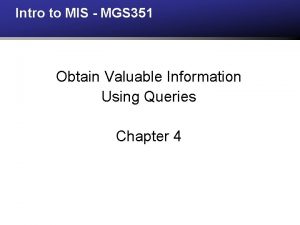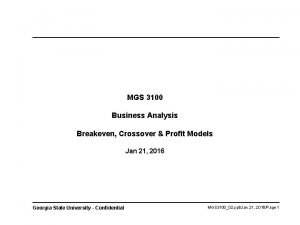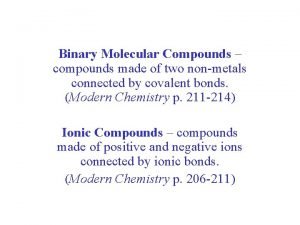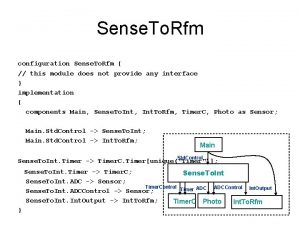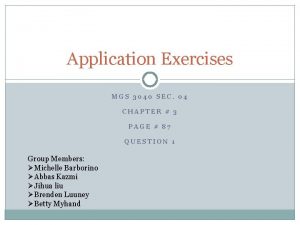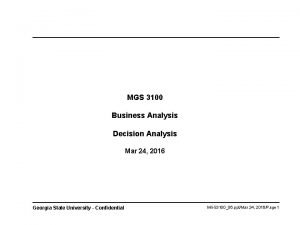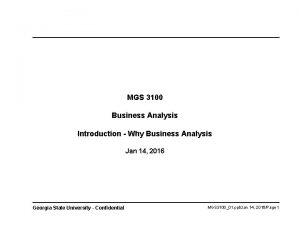RFM Analysis MGS 3040 05 Marni Mc SweenFarmer














- Slides: 14

RFM Analysis MGS 3040 -05 Marni Mc. Sween-Farmer Marco Luzuriaga Annmarie Yoos Collaboration Exercises #2, pg. 366 Ross Ryan

What does RFM stand for? �RFM stands for Recency, Frequency & Monetary Analysis �Recency: When did the customer make their last purchase? �Frequency: How often does the customer make a purchase? �Monetary: How much money does the customer spend? Collaboration Exercises #2, pg. 366

What is RFM Analysis? �RFM Analysis helps companies decide which customers to give select offers and promotional items. �It is a way for companies to find ways to increase customer spending. �Companies can use it to target lost customers and give them incentives to purchase items �RFM Analysis can help companies keep track of their customers and build a relationship that can increase sales and productivity. �It also identifies minimal losses – customers spend low dollar amounts in small quantities Collaboration Exercises #2, pg. 366

How does RFM Analysis work? �First, customers are divided into 5 equal sized groups (20% in each group) �Customers are then given an R, F, & M score �Using a score of 1 to 5, 20% of the most recent customers get an R score of 1. �The second most recent get an R score of 2 and this continues until all 5 groups receive a score. �The 5 groups are reorganized to repeat the procedure for the F & M scores. � (see spreadsheet – Supplier Rankings) Collaboration Exercises #2, pg. 366

What is RFMPD Analysis? �RFMPD includes 2 additional variables. �P stands for Payment. This measures when the company receives payment. �Customers who pay quickly receive a P score of 1 with the slowest paying receiving a score of 5. �D stands for Date. This is the date of the customers last payment. �Customers are sorted by decreasing D values. �The final score is based on a value for R, F, M, & P. Collaboration Exercises #2, pg. 366

Uses of RFM Analysis �Marketing departments of any company �Customer Service Departments �Customer Relations Departments �Ranking Suppliers �Ranking Salespeople �Airlines �Credit Card Companies Collaboration Exercises #2, pg. 366

Strengths of RFM Analysis �Companies have data that can be used for target marketing. �Marketing budgets will be focused on customers who are more recent, more frequent and spend more. �Specific targeting can increase profit and reduce costs; companies gain by not spending on customers who will not add value �You can offer incentives to middle scoring customers to increase their purchases �Analysis is quick and easy to interpret Collaboration Exercises #2, pg. 366

Weaknesses of RFM Analysis �It only looks at three variables and there may be others that are more important �Customers with low RFM scores may be ignored, even though they may have legitimate reasons for spending more with other vendors. �Opportunities may be missed to solidify business relationships leading to loss of future sales and referrals. �A customer with a low recency value and high spending could be ranked lower than a customer who made a recent purchase and spends 10 times less Collaboration Exercises #2, pg. 366

Effectiveness of RFMP Analysis �Customers scoring the top 20% also pay the fastest. Companies will be able make money faster and this can be used to reduce other liabilities. �Customers in the lowest 20% are slow payers and companies can choose to limit credit or change payment terms to reduce the amount of outstanding debt. Collaboration Exercises #2, pg. 366

1, 1, 1, 5 Customers �Customer is one that has recently ordered, buys frequently, spends large amounts of money but they are a slow payer. �To speed up the payment process, companies can change payment terms and offer incentives to pay earlier. �For example, if the due date is 30 days, but payments are received with 10 days, the buyer will receive a 2% discount off the bill (2/10 net 30). Collaboration Exercises #2, pg. 366

5, 5, 5, 1 Customer �This customer has not ordered recently or frequently, spend small amounts of money but always pays on time. �This customer is spending more money with competitors. �Make an effort to find out why the customer is spending elsewhere to see if there is anything the company can improve on. Collaboration Exercises #2, pg. 366

RFMP or RFM? �RFMP is a better method because it include the variable of payment. With more variables, you have a clearer picture of the customer’s value to the company. �RFMP also takes into account the customer’s payment history. �If a customer pays on time, you know that there are no cash flow issues. �Slow payers may be having financial problems which may increase in the future. Collaboration Exercises #2, pg. 366

Using RFM for Salespeople �RFM Analysis of Salespeople gives managers a clear picture of how a salesperson is performing �You can analyze the amount of revenue generated person and compare different salespeople �It is also possible to identify opportunities for additional training, promotion or employment termination. � (see spreadsheet – Salespeople Rankings) Collaboration Exercises #2, pg. 366

RFM or No RFM? �RFM is best suited for companies who offer a rewards program. They are able to track spending and can offer their high profile clients incentives to spend more. �RFM is worst suited to companies who provide products that are unique and will not be purchased in large quantities. Collaboration Exercises #2, pg. 366

